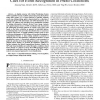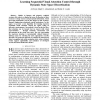166 search results - page 20 / 34 » A Hybrid Learning Approach for Better Recognition of Visual ... |
PAMI
2011
12 years 10 months ago
2011
—We present a discriminative part-based approach for human action recognition from video sequences using motion features. Our model is based on the recently proposed hidden condi...
ICPR
2008
IEEE
14 years 8 months ago
2008
IEEE
This paper presents a method for visual object categorization based on encoding the joint textural information in objects and the surrounding background, and requiring no segmenta...
PR
2007
13 years 7 months ago
2007
A reliable system for visual learning and recognition should enable a selective treatment of individual parts of input data and should successfully deal with noise and occlusions....
TMM
2010
13 years 2 months ago
2010
As digital cameras with Global Positioning System (GPS) capability become available and people geotag their photos using other means, it is of great interest to annotate semantic e...
ICRA
2009
IEEE
14 years 2 months ago
2009
IEEE
² Similar to humans and primates, artificial creatures like robots are limited in terms of allocation of their resources to huge sensory and perceptual information. Serial process...


